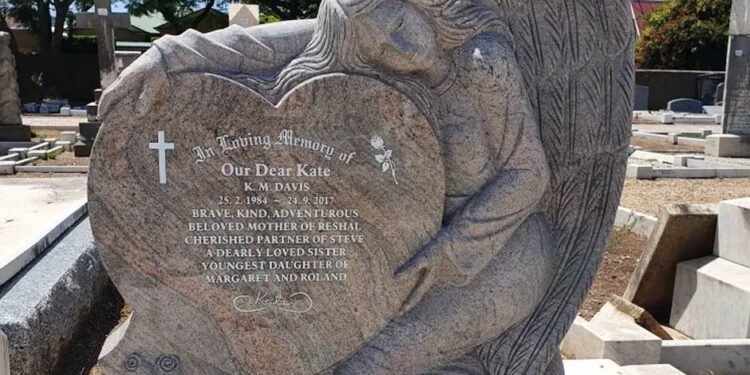When you’re selecting a custom headstone to memorialize a loved one, durability and longevity are crucial considerations. A headstone not only serves as a physical marker of where someone is laid to rest but also as a symbol of their lasting memory. Therefore, ensuring that a custom headstone can withstand harsh weather and environmental conditions is vital. In this guide, we’ll walk you through the key factors to consider, focusing on the types of headstones, materials used, and essential tips for maintenance and preservation.
Understanding the Types of Headstones
Before diving into durability and environmental factors, it’s important to understand the different types of headstones available. Headstones, or gravestones, come in a variety of designs, shapes, and sizes. These factors not only influence aesthetics but also play a significant role in how well the stone endures over time.
Here are the main types of headstones:
- Flat Headstones: Also known as grave markers or lawn-level markers, these lie flat on the ground. While they are sleek and unobtrusive, they are more exposed to elements like rain, snow, and even mowing equipment, which could increase wear over time.
- Upright Headstones: These are the most traditional type of headstone, mounted vertically on a base. They are typically more resilient because only one face is fully exposed to the elements.
- Slant Headstones: These have a sloping design and offer a middle ground between flat and upright headstones. Because of their angle, they shed water and debris more easily than flat stones, which makes them a good option in rainy or snowy climates.
- Bevel Headstones: These stones sit above ground but have a slightly slanted surface. They are similar to flat headstones but less vulnerable to debris accumulation.
- Bench Memorials: This type of marker serves a dual purpose: it offers a place to sit while also commemorating a loved one. Benches are often made of durable materials like granite, making them weather-resistant.
Choosing the Right Material
The material of the headstone plays the most significant role in its ability to withstand weather and environmental conditions. Not all materials are created equal in terms of durability, and your choice can affect how well the stone holds up over time.
Here are the most common materials used for headstones:
- Granite: Granite is one of the most popular choices for headstones due to its durability and availability. It is extremely hard and weather-resistant, making it a long-lasting option for any type of headstone. It can endure rain, wind, and even snow without significant wear. Granite also comes in various colors and can be easily customized with engravings or designs.
- Marble: Marble is another aesthetically pleasing material for headstones, but it is less durable than granite. Over time, marble can be prone to erosion and weathering, especially in areas with acid rain or high moisture. While marble has a classic look, it’s important to understand that it may require more maintenance to retain its beauty.
- Bronze: This material is often used in combination with granite bases for plaques or grave markers. Bronze is highly resistant to weathering and can maintain its appearance over time with minimal upkeep. However, oxidation can cause a greenish patina to form, which is something to consider if you prefer a clean, metallic look.
- Sandstone and Limestone: These are softer stones that were more commonly used in the past. While they can be beautifully carved, they tend to erode quickly when exposed to the elements, making them less ideal for long-term durability.
- Slate: Although less common, slate offers a unique, rustic appearance and is relatively durable compared to marble and sandstone. However, it may still suffer from cracks or splits due to freeze-thaw cycles in colder climates.
In summary, granite and bronze are the most durable materials for headstones, offering both aesthetic appeal and weather resistance. If longevity is a top priority, these materials are your best bet.
Consider Environmental Factors
While material choice is crucial, the local environment and climate where the headstone will be placed also play a role in how well it stands up to time. Here are some environmental conditions to consider:
- Rain and Humidity: Constant exposure to moisture can lead to erosion in certain materials, such as marble or sandstone. Granite and bronze are more moisture-resistant, making them ideal for wet climates.
- Freeze-Thaw Cycles: In regions where the temperature fluctuates dramatically between day and night or between seasons, the expansion and contraction of water trapped in porous materials can cause cracking. Granite’s density makes it less susceptible to this, while softer stones may develop splits or flakes over time.
- UV Exposure: Prolonged exposure to direct sunlight can cause some materials to fade or degrade. While this is more of an issue with painted or etched designs, it can also affect certain types of stone. Granite, especially darker colors, tends to retain its color well even after years of sun exposure.
- Wind and Debris: In areas prone to high winds or storms, debris like branches or rocks can damage the headstone surface. A more durable material like granite or bronze is better suited for such environments.
- Soil Conditions: The soil itself can have an impact on the headstone, particularly with flat markers. In areas with heavy soil, the headstone may sink or shift over time, leading to instability. A proper foundation is essential to avoid future damage.
Foundation and Installation
The way a headstone is installed can dramatically influence its durability. A poorly set headstone may lean, sink, or crack over time due to soil movement or environmental pressures. Here’s what to consider:
- Concrete Foundations: Many cemeteries require a concrete foundation for larger upright headstones. This ensures that the stone is properly supported and less likely to shift over time. A good foundation can help prevent cracking or sinking in soft soils.
- Reinforced Anchoring: For taller or heavier headstones, additional anchoring can help secure the stone in place, especially in areas prone to high winds or earthquakes. Bolts or pins may be used to connect the stone to its base more securely.
Maintenance and Preservation
Even the most durable materials benefit from regular maintenance to ensure they remain in good condition for generations. Here are some tips for maintaining a custom headstone:
- Cleaning: Regular cleaning can help prevent the buildup of dirt, moss, or lichen, which can degrade the stone surface over time. Use a soft brush and mild detergent for cleaning, and avoid harsh chemicals that could damage the stone. For bronze markers, a special cleaner may be required to maintain the metal’s appearance.
- Sealing: While sealing may not be necessary for all headstone materials, some families choose to seal certain types of stone to reduce moisture penetration and prevent stains. However, be cautious about sealing softer materials like sandstone, as improper sealing can trap moisture inside the stone and cause internal damage.
- Repairs: If you notice cracks, chips, or other signs of damage, it’s important to address these issues as soon as possible. Small cracks can be filled or repaired to prevent further damage, while larger issues may require professional restoration.
The Importance of Working with a Skilled Monument Maker
Finally, ensuring that your custom headstone withstands environmental conditions begins with choosing a skilled and reputable monument maker. Experienced professionals will know the best materials and installation practices to use based on your location and the types of headstones available. They will also guide you in making choices that balance beauty, durability, and cost.
When selecting a monument maker, like Tegeler Monument, don’t hesitate to ask about the materials they recommend for your specific climate. You can also inquire about the warranties
Conclusion
A custom headstone is an enduring tribute to a loved one, so it’s essential to make choices that ensure its longevity. By carefully considering the types of headstones, choosing the right materials, and paying attention to environmental factors, you can be confident that your memorial will withstand the test of time. Combine this with proper maintenance and expert installation, and your loved one’s memory will remain beautifully preserved for generations to come.












